Second World War civilian identity discs
In early 1942, with attacks on Darwin and Western Australia heightening the perceived threat of Japanese invasion, Australian newspapers reported recommendations (particularly from the medical fraternity) that identity discs – bearing details such as name, address, and blood type – be issued to civilians in case of air raids.
Government- and organisation-issued discs:
Federal
By March 1942 some Government employees were issued with identity discs that would be marked with the name, age address and religion of the wearer.
In late April, Federal Minister for Home Security, Hubert Lazzarini, stated that Australia would wait until receiving further advice from Britain, but that based on the advice already received (and the low likelihood of bombing anything near the levels experienced in Britain) he felt that the material and labour involved would not be justified. Months later the British had determined the scheme unjustifiable and did not require all citizens to have identity discs; Australia followed suit.
Some state governments and state or local organisations created and issued identity discs under their own auspices. Some examples are listed below. Please note that this list is not exhaustive.
South Australia
By March 1942 several South Australian schools had issued children with cardboard identity discs, which were carried in fabric bags around their necks.
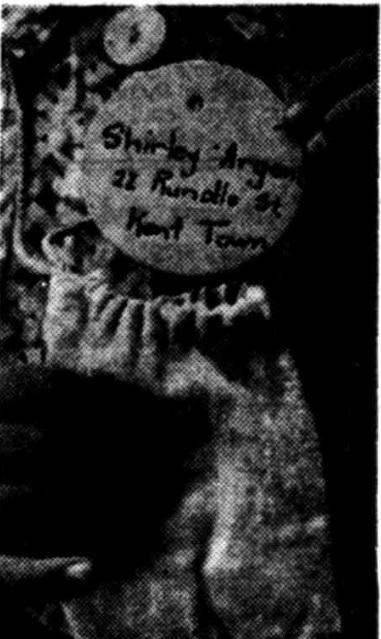
Image from News (Adelaide) 4 March 1942 of a cardboard disc for a child from Rose Park with its fabric pouch (via Trove )
Queensland
Queensland was the only state government to officially manufacture discs for the civilian population. In January 1942, Queensland Minister for Civil Defence, Ned Hanlon, announced that 1,200 Queensland school children had been issued with identification badges, and recommended parents give themselves and their children identity discs.
Queensland Cabinet voted in April 1942 to approve the manufacture of discs by the Government Printing Office. These small oval metal discs would be stamped or engraved with the name and address of the owner, and were to be available for purchase at the cost of 3d per disc (equivalent to about $1 in 2019).
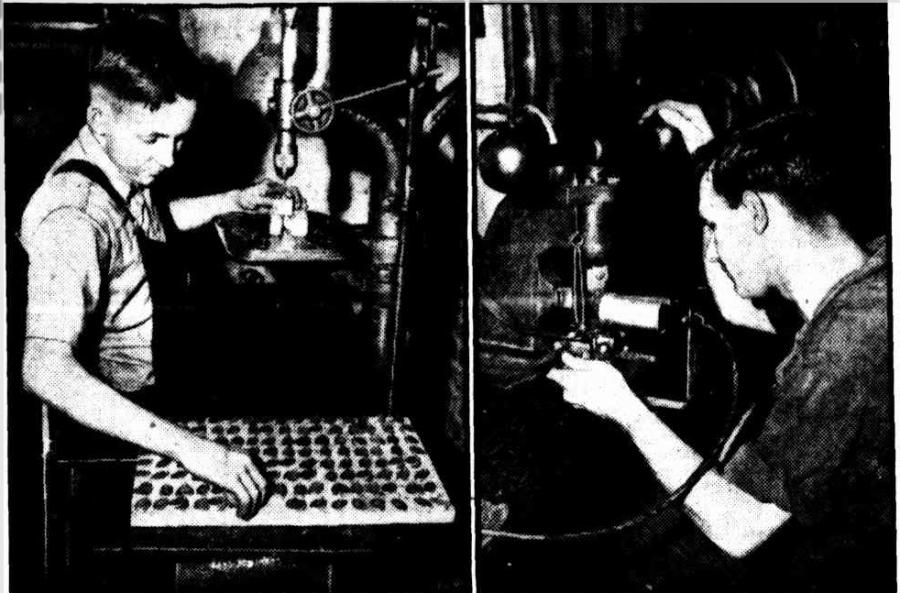
Image from The Courier Mail, Brisbane, of the Queensland Government discs being manufactured. The first image shows the holes being drilled and the second, stamping the wearer’s details (via Trove )
By June 1942 more than 62,000 orders had been received by the Education Department for discs for schoolchildren. Other schools appear to have sourced their own discs, as Memorial staff have seen examples of circular discs issued to children in Queensland by their schools.
New South Wales
By mid-April 1942, identity discs for blood donors from the Lismore National Emergency Services group for the Lismore Blood Bank were issued at Council Chambers and made available from the organiser, Miss N Vidler. Two hundreds donors were registered at the bank.
By July 1942 over 10,000 school children from 40 public and private schools in the Greater Newcastle area were issued with cardboard identity discs by the Newcastle Evacuation Services executive committee. As mothers raised concerns about durability, children were asked to provide protective covers – either covering the discs in cellophane or making a cellophane pocket to hold the disc. Success was variable and in April 1942 the Islington Parents and Citizens Association noted that some discs were not protected and there were concerns for their longevity.
More than 2,000 leather discs were issued to children in the Lane Cove Municipality in August 1942 by the Civilian Aid Service (CAS) Centre. Children were required to wear the discs in addition to any other identity discs, or to add their CAS number to their original disc.
Western Australia
In February 1942 a private donor provided funds for families with large numbers of children or small incomes to obtain engraved identity discs from the Citizens’ Committee for Air Raid Precautions and Evacuation in Perth. Families were able apply to the committee for free discs, which would normally cost 10d (the equivalent of $3.15 in 2019) from department stores.
Privately purchased discs:
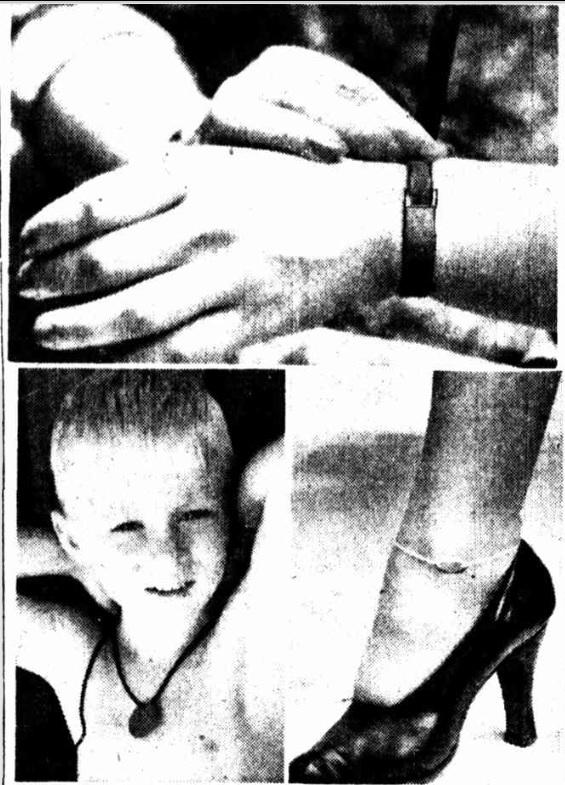
Images of three types of identity discs available for purchase – wrist version, fibre disc and anklet from The Telegraph (Brisbane) 4 Feb 1942 (via Trove )
Discs were available for sale from department stores, gift shops, bike shops, newsagents and jewellers. They were usually circular or oval and could be worn on chain or string around the neck, or as a wrist or ankle bracelet. Most were stainless steel, but discs were also made from silver, gold, leather or compressed fibre.
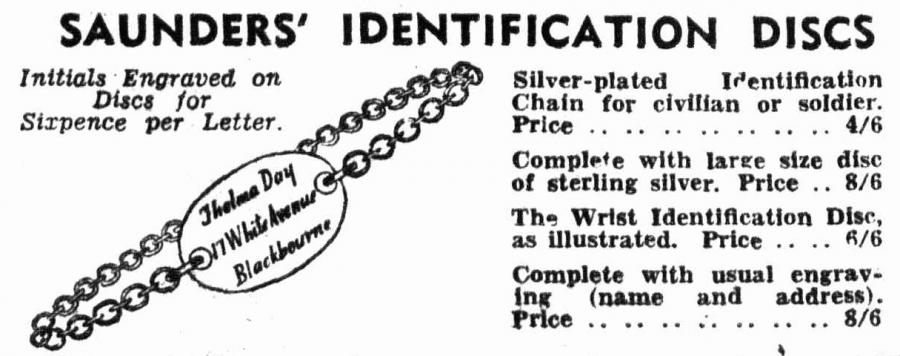
Advertisement in The Daily Telegraph, 7 May 1942 by Saunders jewellery and gift stores for their range of identification discs.
In April 1942, demand for identity discs was so great in Adelaide there were issues with keeping up with demand. Names and addresses were engraved on the front of discs and the names of children’s schools were engraved on the back. There were recommendations that information about blood group be included if known, however this was difficult and expensive for large families and was not considered mandatory.
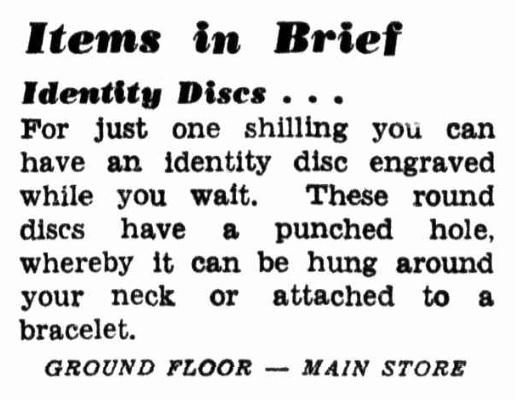
David Jones advertisement for engraved identity discs costing a shilling, The Daily Telegraph, April 1942 (via Trove)
Engraved stainless steel discs usually cost between 6d (about $1.90 in 2019) and 1’9 (about $6.60 in 2019) often including engraving of name and address. Un-engraved silver discs could cost 2’11 (about $11 in 2019) and engraved discs could cost up to 12’6 (about $47 in 2019).
Stainless steel engraved identity disc for 16-year-old John Hudson Fysh, organised by his father, Sir Wilmot Hudson Fysh, in 1942 during the Japanese invasion scare. The disc includes John’s name, address and religion on the front, and the name of his school on the back.
Between February and May 1942 various states banned the manufacture of unnecessary luxury items. Jewellery, excluding wedding rings, was included in this ban. Given that commercially made identity discs were regarded as jewellery, existing stock could be sold, but no new discs could be made. In June 1942 the ban was lifted for the manufacture of identity discs.
Identity disc made by railway worker Leonard Don for his mother in law, Isabella Frazier. The family lived near the railway station at Graceville, Brisbane. Fearing that the station could be a target for Japanese bombing raids, Leonard made identity discs for family members.
While some schools issued cardboard discs to school children, parents were concerned about their durability; some privately purchased discs for their families. While some women wore identity discs in lieu of their government-issued identity cards (which they found irritating to carry around), the Commonwealth Electoral Officer in charge of civilian registration, H.M.G. Burton, advised that these discs were not a legitimate replacement.
Some civilians with family members in the Defence Force obtained military identity discs, which could be stamped using the same dies, through unofficial means.
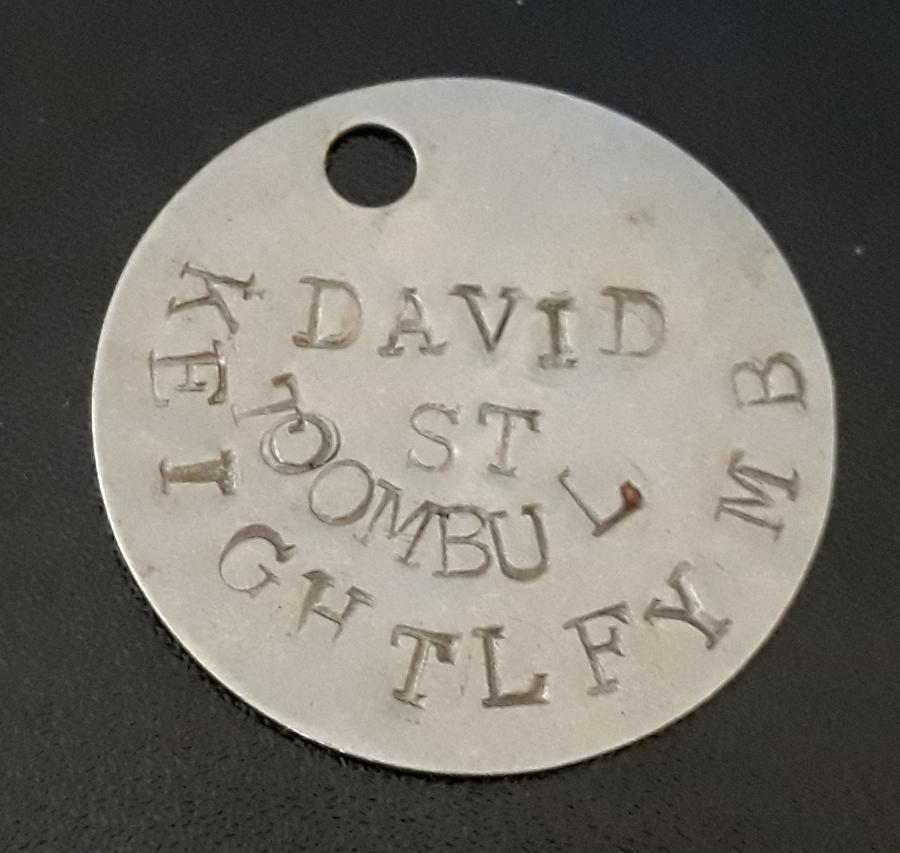
No. 2 stainless steel identity disc stamped with Defence dies, of the type issued to the RAAF through the war, and the AIF from 1943. Made for Maud Keightley of Toombul, Queensland. Maud’s father served in the Citizens Military Force and her fiancé in the AIF and she may have obtained this disc from one of them, or from a friend or family member in the RAAF (courtesy of D Rutherford)
1942 was the peak period for the issuing and purchase of civilian identity discs, after which demand waned. There were no further official moves to issue discs to the populace and after 1943 commercially available discs were rarely advertised.
Sources:
Australian war Memorial collection
Privately held identity discs
Reserve Bank of Australia Pre-decimal inflation calculator https://www.rba.gov.au/calculator/annualPreDecimal.html
Newspapers (Via Trove - https://trove.nla.gov.au/newspaper/):
The Central Queensland Herald (Rockhampton) 15 January 1942
The Daily News (Perth) 12 February 1942
News (Adelaide) 2 March 1942
Benalla Ensign 13 March 1942
The Newcastle Sun 20 March 1942
Tweed Daily 8 April 1942
Barrier Miner (Broken Hill) 9 April 1942
Horsham Times 10 April 1942
Northern Star (Lismore) 18 April 1942
The Newcastle Sun 21 April 1942
Daily Advertiser (Wagga) 30 April 1942
Newcastle Morning Herald and Miners’ Advocate 30 April 1942
Newcastle Sun 30 April 1942
South Coast Bulletin (Qld) 19 June 1942
Newcastle Morning Herald and Miners’ Advocate 30 July 1942
Newcastle Morning Herald and Miners’ Advocate 31 July 1942
Daily Telegraph (Sydney) 9 August 1942
Daily News (Perth) 28 August 1942

